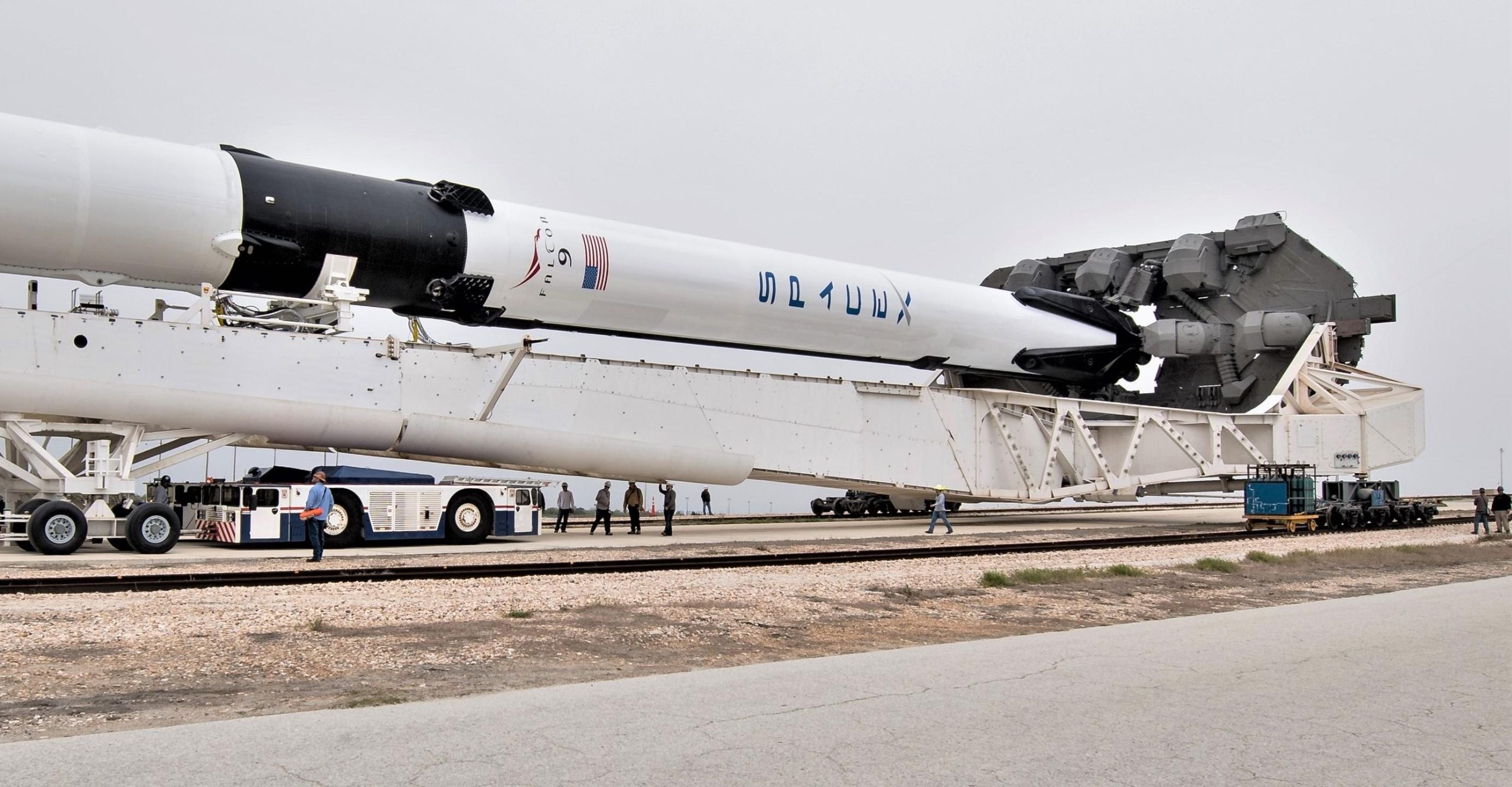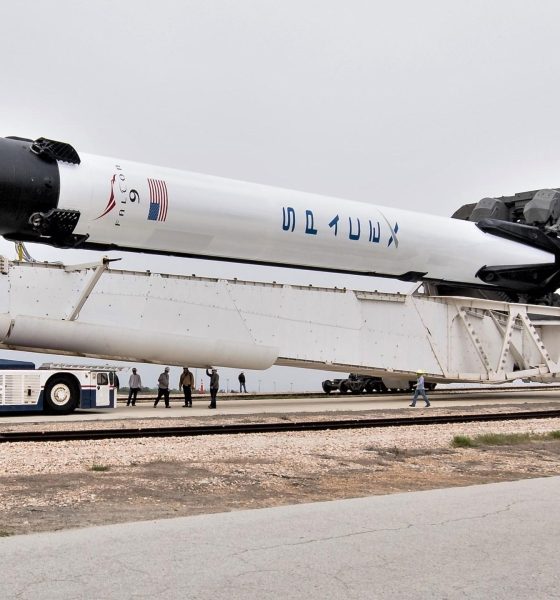

News
SpaceX Falcon 9 wins Korean launch contract as 2019 mystery missions persist
SpaceX has silently announced that Falcon 9 won a contract for a South Korean military communications satellite, currently scheduled to launch from the company’s Cape Canaveral Air Force Station (CCAFS) LC-40 pad no earlier than November 2019.
Subcontracted from Lockheed Martin to Airbus Defense and Space in 2016, the satellite – known as Anasis II (formerly KMilSatCom 1) – is based on a common bus built by Airbus and could weigh anywhere from 3500 to 6000 kilograms (7500-13,200 lb). Falcon 9 will be tasked with launching Anasis II to geostationary transfer orbit (GTO), after which the satellite will use its own onboard propulsion to circularize the orbit and begin operations. Although the Korean contract brings SpaceX one step closer to its goal of 18-21 launches (excluding Starlink) in 2019, it also raises the question: what mystery missions are missing from public launch manifests?
Manifest Mystery
As previously discussed in both Teslarati articles and newsletters, comments from SpaceX executives in February and May 2019 reiterate the company’s expectation of 18-21 launches in 2019, excluding Starlink. Hofeller’s “more than 21 launches” admittedly came more than two months before a catastrophic Crew Dragon failure threw the spacecraft’s launch manifest into limbo.
Three months later, SpaceX President and COO Gwynne Shotwell reiterated the idea that SpaceX could beat its 2018 launch record (21 launches) or at least get close. Curiously, she specifically noted that SpaceX’s purported 18-21 launch manifest excluded Starlink missions, of which SpaceX has already launched one. In short, SpaceX has completed 7 launches in 2019 (6 if Starlink v0.9 is excluded). The company’s public manifest – unofficially cobbled together by fans – shows 9 more launches scheduled for a total of 15 non-Starlink launches in 2019.
To meet Shotwell’s expected 18-21 non-Starlink launches, anywhere from 3 to 6 missions are apparently missing from publicly-managed launch manifests. It’s unclear if SpaceX actually has enough launch-ready customers to achieve those ambitious targets. Additionally, SpaceX is currently on track to complete 8 launches total (1 Starlink) in the first half of 2019. In 2017 and 2018 (two years without interruption), SpaceX consistently launched an equivalent number (or more) missions in the first half of the year when compared to the second half, and both years have maxed out at 9 launches in H2.
SpaceX will have to beat that H2 record to reach 18 launches in 2019 even if Starlink missions are counted. Meanwhile, SpaceX says that as many as 1-5 additional Starlink launches are scheduled for 2019, bringing the total number of missions as high as 20-27 in differing best-case scenarios. Practically speaking, between SpaceX’s Pad 39A and LC-40 launch facilities, the company could easily maintain a biweekly or even weekly cadence (13-26 launches in H2 2019). The real constraint, however, is hardware availability – i.e. whether SpaceX has the rocket pieces and flight-ready satellite(s) it needs to launch a given mission.


Can SpaceX do it?
This is an extremely hard question to answer, as all details that really matter are of the organizational, company-secrets sort that SpaceX just doesn’t publicize. From a technical and practical perspective, the answer is a reasonable confident “yes.” If Falcon Heavy Flight 3 (STP-2) is completed successfully, SpaceX will have an impressive fleet of at least 8 flight-proven Falcon 9-class boosters. Even assuming that no progress is made beyond the current Block 5 turnaround average of ~110 days (~3.5 months), SpaceX’s current fleet should be able to immediately support four launches and an additional 8-12 before the end of 2019.
The primary limit, then, would be SpaceX’s ability to produce Falcon 9 upper stages and fairings, as well as the stamina and quality of the company’s managers and employees. Even then, the question of SpaceX’s 3-6 mystery launches will remain unanswered until either the customer or launch provider choose to open up. For now, we wait…
Check out Teslarati’s Marketplace! We offer Tesla accessories, including for the Tesla Cybertruck and Tesla Model 3.

Elon Musk
Elon Musk’s X will start using a Tesla-like software update strategy
The initiative seems designed to accelerate updates to the social media platform, while maintaining maximum transparency.

Elon Musk’s social media platform X will adopt a Tesla-esque approach to software updates for its algorithm.
The initiative seems designed to accelerate updates to the social media platform, while maintaining maximum transparency.
X’s updates to its updates
As per Musk in a post on X, the social media company will be making a new algorithm to determine what organic and advertising posts are recommended to users. These updates would then be repeated every four weeks.
“We will make the new 𝕏 algorithm, including all code used to determine what organic and advertising posts are recommended to users, open source in 7 days. This will be repeated every 4 weeks, with comprehensive developer notes, to help you understand what changed,” Musk wrote in his post.
The initiative somewhat mirrors Tesla’s over-the-air update model, where vehicle software is regularly refined and pushed to users with detailed release notes. This should allow users to better understand the details of X’s every update and foster a healthy feedback loop for the social media platform.
xAI and X
X, formerly Twitter, has been acquired by Elon Musk’s artificial intelligence startup, xAI last year. Since then, xAI has seen a rapid rise in valuation. Following the company’s the company’s upsized $20 billion Series E funding round, estimates now suggest that xAI is worth tens about $230 to $235 billion. That’s several times larger than Tesla when Elon Musk received his controversial 2018 CEO Performance Award.
As per xAI, the Series E funding round attracted a diverse group of investors, including Valor Equity Partners, Stepstone Group, Fidelity Management & Research Company, Qatar Investment Authority, MGX, and Baron Capital Group, among others. Strategic partners NVIDIA and Cisco Investments also continued support for building the world’s largest GPU clusters.
News
Tesla FSD Supervised wins MotorTrend’s Best Driver Assistance Award
The decision marks a notable reversal for the publication from prior years, with judges citing major real-world improvements that pushed Tesla’s latest FSD software ahead of every competing ADAS system.

Tesla’s Full Self-Driving (Supervised) system has been named the best driver-assistance technology on the market, earning top honors at the 2026 MotorTrend Best Tech Awards.
The decision marks a notable reversal for the publication from prior years, with judges citing major real-world improvements that pushed Tesla’s latest FSD software ahead of every competing ADAS system. And it wasn’t even close.
MotorTrend reverses course
MotorTrend awarded Tesla FSD (Supervised) its 2026 Best Tech Driver Assistance title after extensive testing of the latest v14 software. The publication acknowledged that it had previously criticized earlier versions of FSD for erratic behavior and near-miss incidents, ultimately favoring rivals such as GM’s Super Cruise in earlier evaluations.
According to MotorTrend, the newest iteration of FSD resolved many of those shortcomings. Testers said v14 showed far smoother behavior in complex urban scenarios, including unprotected left turns, traffic circles, emergency vehicles, and dense city streets. While the system still requires constant driver supervision, judges concluded that no other advanced driver-assistance system currently matches its breadth of capability.
Unlike rival systems that rely on combinations of cameras, radar, lidar, and mapped highways, Tesla’s FSD operates using a camera-only approach and is capable of driving on city streets, rural roads, and freeways. MotorTrend stated that pure utility, the ability to handle nearly all road types, ultimately separated FSD from competitors like Ford BlueCruise, GM Super Cruise, and BMW’s Highway Assistant.
High cost and high capability
MotorTrend also addressed FSD’s pricing, which remains significantly higher than rival systems. Tesla currently charges $8,000 for a one-time purchase or $99 per month for a subscription, compared with far lower upfront and subscription costs from other automakers. The publication noted that the premium is justified given FSD’s unmatched scope and continuous software evolution.
Safety remained a central focus of the evaluation. While testers reported collision-free operation over thousands of miles, they noted ongoing concerns around FSD’s configurable driving modes, including options that allow aggressive driving and speeds beyond posted limits. MotorTrend emphasized that, like all Level 2 systems, FSD still depends on a fully attentive human driver at all times.
Despite those caveats, the publication concluded that Tesla’s rapid software progress fundamentally reshaped the competitive landscape. For drivers seeking the most capable hands-on driver-assistance system available today, MotorTrend concluded Tesla FSD (Supervised) now stands alone at the top.
News
Elon Musk’s Grokipedia surges to 5.6M articles, almost 79% of English Wikipedia
The explosive growth marks a major milestone for the AI-powered online encyclopedia, which was launched by Elon Musk’s xAI just months ago.

Elon Musk’s Grokipedia has grown to an impressive 5,615,201 articles as of today, closing in on 79% of the English Wikipedia’s current total of 7,119,376 articles.
The explosive growth marks a major milestone for the AI-powered online encyclopedia, which was launched by Elon Musk’s xAI just months ago. Needless to say, it would only be a matter of time before Grokipedia exceeds English Wikipedia in sheer volume.
Grokipedia’s rapid growth
xAI’s vision for Grokipedia emphasizes neutrality, while Grok’s reasoning capabilities allow for fast drafting and fact-checking. When Elon Musk announced the initiative in late September 2025, he noted that Grokipedia would be an improvement to Wikipedia because it would be designed to avoid bias.
At the time, Musk noted that Grokipedia “is a necessary step towards the xAI goal of understanding the Universe.”
Grokipedia was launched in late October, and while xAI was careful to list it only as Version 0.1 at the time, the online encyclopedia immediately earned praise. Wikipedia co-founder Larry Sanger highlighted the project’s innovative approach, noting how it leverages AI to fill knowledge gaps and enable rapid updates. Netizens also observed how Grokipedia tends to present articles in a more objective manner compared to Wikipedia, which is edited by humans.
Elon Musk’s ambitious plans
With 5,615,201 total articles, Grokipedia has now grown to almost 79% of English Wikipedia’s article base. This is incredibly quick, though Grokipedia remains text-only for now. xAI, for its part, has now updated the online encyclopedia’s iteration to v0.2.
Elon Musk has shared bold ideas for Grokipedia, including sending a record of the entire knowledge base to space as part of xAI’s mission to preserve and expand human understanding. At some point, Musk stated that Grokipedia will be renamed to Encyclopedia Galactica, and it will be sent to the cosmos.
“When Grokipedia is good enough (long way to go), we will change the name to Encyclopedia Galactica. It will be an open source distillation of all knowledge, including audio, images and video. Join xAI to help build the sci-fi version of the Library of Alexandria!” Musk wrote, adding in a later post that “Copies will be etched in stone and sent to the Moon, Mars and beyond. This time, it will not be lost.”











